Mechanical work in the SI system. Mechanical work. Power
Let the body, on which the force acts, pass, moving along a certain trajectory, the path s. In this case, the force either changes the speed of the body, imparting acceleration to it, or compensates for the action of another force (or forces) that opposes the movement. The action on the path s is characterized by a quantity called work.
Mechanical work is a scalar value equal to the product of the projection of the force on the direction of movement Fs and the path s, traversable point application of force (Fig. 22):
A = Fs*s.(56)
Expression (56) is valid if the value of the projection of the force Fs on the direction of movement (i.e., on the direction of speed) remains unchanged all the time. In particular, this takes place when the body moves in a straight line and a force of constant magnitude forms a constant angle α with the direction of motion. Since Fs = F * cos(α), expression (47) can be given the following form:
A = F*s*cos(α).
If is a displacement vector, then the work is calculated as the scalar product of two vectors and :
 . (57)
. (57)
Work is an algebraic quantity. If the force and direction of movement form sharp corner(cos(α) > 0), the work is positive. If the angle α is obtuse (cos(α)< 0), работа отрицательна. При α = π/2 работа равна нулю. Последнее обстоятельство особенно отчетливо показывает, что понятие работы в механике существенно отличается от обыденного представления о работе. В обыденном понимании всякое усилие, в частности и мускульное напряжение, всегда сопровождается совершением работы. Например, для того чтобы держать тяжелый груз, стоя неподвижно, а тем более для того, чтобы перенести этот груз по горизонтальному пути, носильщик затрачивает много усилий, т. е. «совершает работу». Однако это – «физиологическая» работа. mechanical work in these cases is zero.

Work when moving under the influence of force
If the magnitude of the projection of the force on the direction of movement does not remain constant during movement, then the work is expressed as an integral:
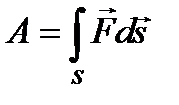 . (58)
. (58)
An integral of this kind in mathematics is called a curvilinear integral along the trajectory S. The argument here is a vector variable , which can vary both in absolute value and in direction. Under the integral sign is the scalar product of the force vector and the elementary displacement vector.
A unit of work is the work done by a force equal to one and acting in the direction of movement, on a path equal to one. in SI the unit of work is the joule (J), which equals work performed by a force of 1 newton on a path of 1 meter:
1J = 1N * 1m.
In the CGS, the unit of work is the erg, which is equal to the work done by a force of 1 dyne in a path of 1 centimeter. 1J = 10 7 erg.
Sometimes a non-systemic unit kilogrammeter (kg * m) is used. This is the work done by a force of 1 kg on a path of 1 meter. 1kg*m = 9.81 J.
Mechanical work is the energy characteristic of motion physical bodies, which has a scalar form. It is equal to the modulus of the force acting on the body, multiplied by the modulus of displacement caused by this force and the cosine of the angle between them.
Formula 1 - Mechanical work.
F - Force acting on the body.
s - body movement.
cosa - Cosine of the angle between force and displacement.
This formula has general form. If the angle between the applied force and the displacement is zero, then the cosine is 1. Accordingly, the work will only be equal to the product of the force and the displacement. Simply put, if the body moves in the direction of application of the force, then the mechanical work is equal to the product of the force and the displacement.
Second special case when the angle between the force acting on the body and its displacement is 90 degrees. In this case, the cosine of 90 degrees is equal to zero, respectively, the work will be equal to zero. And indeed, what happens is we apply force in one direction, and the body moves perpendicular to it. That is, the body is obviously not moving under the influence of our force. Thus, the work of our force to move the body is zero.
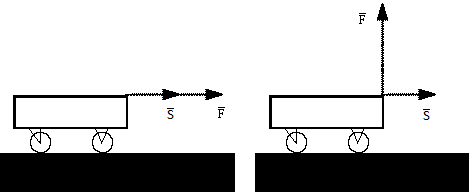
Figure 1 - The work of forces when moving the body.
If more than one force acts on the body, then the total force acting on the body is calculated. And then it is substituted into the formula as the only force. A body under the action of a force can move not only in a straight line, but also along an arbitrary trajectory. In this case, the work is calculated for a small section of movement, which can be considered straight and then summed up along the entire path.
Work can be both positive and negative. That is, if the displacement and force coincide in direction, then the work is positive. And if the force is applied in one direction, and the body moves in the other, then the work will be negative. An example of negative work is the work of the friction force. Since the friction force is directed against the movement. Imagine a body moving along a plane. A force applied to a body pushes it in a certain direction. This force does positive work to move the body. But at the same time, the friction force does negative work. It slows down the movement of the body and is directed towards its movement.
Figure 2 - Force of movement and friction.
Work in mechanics is measured in Joules. One Joule is the work done by a force of one Newton when a body moves one meter. In addition to the direction of movement of the body, the magnitude of the applied force can also change. For example, when a spring is compressed, the force applied to it will increase in proportion to the distance traveled. In this case, the work is calculated by the formula.
Formula 2 - Work of compression of a spring.
k is the stiffness of the spring.
x - move coordinate.
9. Mechanical work and power
If the force acting on the body causes it to move, then the action of the force is characterized by mechanical work
Where is the angle between the direction of force and displacement. The formula is valid for the case when the body moves in a straight line and the force acting on it remains constant. If the force changes, then.
Mechanical work is a measure of energy change. The unit of work in the C system is the joule (J).
The average power is called the value equal to the ratio of work to the period of time for which it is performed.
Instantaneous power is determined by the formula. Considering that, we get where v- instantaneous speed.
The unit of power in the SI system is the watt (W).
In practice, an off-system unit of power is often used - horsepower.
1 HP = 735 W
10. Kinetic and potential energy
A physical quantity that characterizes the ability of a body or system of bodies to do work is called energy.
Energy can be due to the movement of the body at a certain speed (kinetic energy), as well as the presence of the body in a potential field of forces (potential energy).
Kinetic energy
Consider the case when a body with mass m under the influence of force F changes its speed from to. Determine the work of the force applied to the body
Since mechanical work is a measure of energy change, the value is the energy due to the movement of the body.
The energy that a body possesses due to its movement is called kinetic.
The work done by the force when the speed of the body changes is equal to the change in the kinetic energy of the body
Potential energy of a body in the field of gravity
When a body falls m from a height to a height above the Earth, gravity does work
Gravity is a conservative force, and the gravitational field is potential. The work of gravity is equal to the change in the potential energy of the body, taken with the opposite sign
Potential energy of a body in the field of gravity.
Energy, which is determined by the mutual arrangement of bodies or parts of the same body, is called potential.
11. Law of conservation of total mechanical energy
Consider the motion of a body in closed system where only conservative forces act. Let, for example, a body of mass m falls freely. When a body moves from state 1 to state 2, gravity does work
In the same time . Consequently,. Transforming this expression, we get.
The sum of the kinetic and potential energy of the body is called the total mechanical energy of the body.
According to the law of conservation of total mechanical energy: the total mechanical energy of a closed system of bodies interacting with each other only by conservative forces does not change with any movements of these bodies. There are only mutual transformations of potential energy into kinetic energy and vice versa.
Systems in which the total mechanical energy is conserved are called conservative.
Systems in which the total mechanical energy is not conserved are called dissipative (dissipation is the transition of energy to another form, for example, mechanical to internal).
In the general case, the law of conservation of energy in nature is formulated as follows:
The energy of bodies never disappears and does not reappear: it only transforms from one form into another or passes from one body to another.
To be able to characterize the energy characteristics of motion, the concept of mechanical work was introduced. And it is to her in her various manifestations that the article is devoted. To understand the topic is both easy and quite complex. The author sincerely tried to make it more understandable and understandable, and one can only hope that the goal has been achieved.
What is mechanical work?
What is it called? If some force works on the body, and as a result of the action of this force, the body moves, then this is called mechanical work. When approached from the point of view scientific philosophy here we can highlight several additional aspects, but the article will cover the topic from the point of view of physics. Mechanical work is not difficult if you think carefully about the words written here. But the word "mechanical" is usually not written, and everything is reduced to the word "work". But not every job is mechanical. Here a man sits and thinks. Does it work? Mentally yes! But is it mechanical work? No. What if the person is walking? If the body moves under the influence of a force, then this is mechanical work. Everything is simple. In other words, the force acting on the body does (mechanical) work. And one more thing: it is work that can characterize the result of the action of a certain force. So if a person walks, then certain forces (friction, gravity, etc.) perform mechanical work on a person, and as a result of their action, a person changes his point of location, in other words, he moves.
Work like physical quantity equals the force that acts on the body, multiplied by the path that the body made under the influence of this force and in the direction indicated by it. We can say that mechanical work was done if 2 conditions were simultaneously met: the force acted on the body, and it moved in the direction of its action. But it was not performed or is not performed if the force acted, and the body did not change its location in the coordinate system. Here are small examples where mechanical work is not done:
- So a person can fall on a huge boulder in order to move it, but there is not enough strength. The force acts on the stone, but it does not move, and work does not occur.
- The body moves in the coordinate system, and the force is equal to zero or they are all compensated. This can be observed during inertial motion.
- When the direction in which the body moves is perpendicular to the force. When the train moves along a horizontal line, the force of gravity does not do its work.
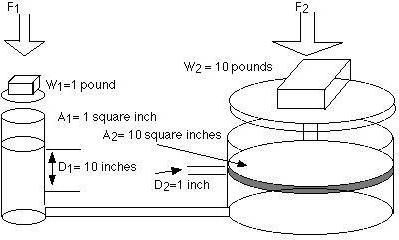 Depending on certain conditions, mechanical work can be negative and positive. So, if the directions and forces, and the movements of the body are the same, then positive work occurs. An example of positive work is the effect of gravity on a falling drop of water. But if the force and direction of movement are opposite, then negative mechanical work occurs. An example of such an option is the rising balloon and the force of gravity, which does negative work. When a body is subjected to the influence of several forces, such work is called "resultant force work".
Depending on certain conditions, mechanical work can be negative and positive. So, if the directions and forces, and the movements of the body are the same, then positive work occurs. An example of positive work is the effect of gravity on a falling drop of water. But if the force and direction of movement are opposite, then negative mechanical work occurs. An example of such an option is the rising balloon and the force of gravity, which does negative work. When a body is subjected to the influence of several forces, such work is called "resultant force work".
Features of practical application (kinetic energy)
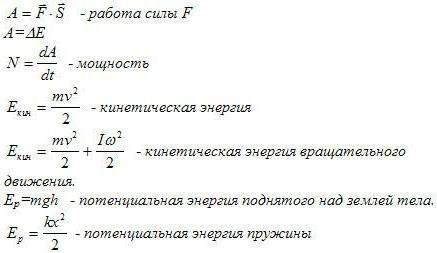 We pass from theory to practical part. Separately, we should talk about mechanical work and its use in physics. As many probably remembered, all the energy of the body is divided into kinetic and potential. When an object is in equilibrium and is not moving anywhere, it potential energy equals total energy, and the kinetic is zero. When the movement begins, the potential energy begins to decrease, the kinetic energy to increase, but in total they are equal to the total energy of the object. For a material point, kinetic energy is defined as the work of the force that accelerated the point from zero to the value H, and in formula form, the kinetics of the body is ½ * M * H, where M is the mass. To find out the kinetic energy of an object that consists of many particles, you need to find the sum of all the kinetic energy of the particles, and this will be kinetic energy body.
We pass from theory to practical part. Separately, we should talk about mechanical work and its use in physics. As many probably remembered, all the energy of the body is divided into kinetic and potential. When an object is in equilibrium and is not moving anywhere, it potential energy equals total energy, and the kinetic is zero. When the movement begins, the potential energy begins to decrease, the kinetic energy to increase, but in total they are equal to the total energy of the object. For a material point, kinetic energy is defined as the work of the force that accelerated the point from zero to the value H, and in formula form, the kinetics of the body is ½ * M * H, where M is the mass. To find out the kinetic energy of an object that consists of many particles, you need to find the sum of all the kinetic energy of the particles, and this will be kinetic energy body.
Features of practical application (potential energy)
In the case when all the forces acting on the body are conservative, and the potential energy is equal to the total, then no work is done. This postulate is known as the law of conservation of mechanical energy. Mechanical energy in a closed system is constant in the time interval. The conservation law is widely used to solve problems from classical mechanics.
Features of practical application (thermodynamics)
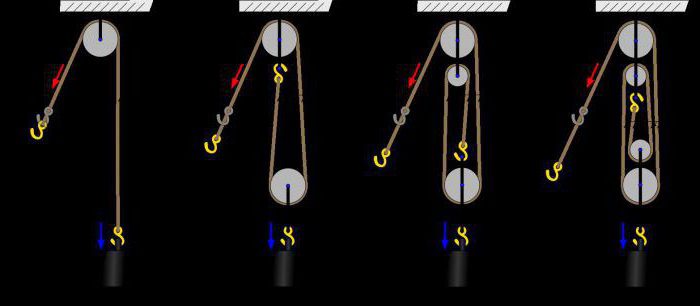 In thermodynamics, the work done by a gas during expansion is calculated by the integral of pressure multiplied by volume. This approach is applicable not only in cases where there is an exact function of volume, but also to all processes that can be displayed in the pressure/volume plane. The knowledge of mechanical work is also applied not only to gases, but to everything that can exert pressure.
In thermodynamics, the work done by a gas during expansion is calculated by the integral of pressure multiplied by volume. This approach is applicable not only in cases where there is an exact function of volume, but also to all processes that can be displayed in the pressure/volume plane. The knowledge of mechanical work is also applied not only to gases, but to everything that can exert pressure.
Features of practical application in practice (theoretical mechanics)
 AT theoretical mechanics all the properties and formulas described above are considered in more detail, in particular, these are projections. She also gives her own definition for various formulas of mechanical work (an example of a definition for the Rimmer integral): the limit to which the sum of all forces tends elementary works, when the fineness of the partition tends to zero, is called the work of the force along the curve. Probably difficult? But nothing with theoretical mechanics all. Yes, and all the mechanical work, physics and other difficulties are over. Further there will be only examples and a conclusion.
AT theoretical mechanics all the properties and formulas described above are considered in more detail, in particular, these are projections. She also gives her own definition for various formulas of mechanical work (an example of a definition for the Rimmer integral): the limit to which the sum of all forces tends elementary works, when the fineness of the partition tends to zero, is called the work of the force along the curve. Probably difficult? But nothing with theoretical mechanics all. Yes, and all the mechanical work, physics and other difficulties are over. Further there will be only examples and a conclusion.
Mechanical work units
The SI uses joules to measure work, while the GHS uses ergs:
- 1 J = 1 kg m²/s² = 1 Nm
- 1 erg = 1 g cm²/s² = 1 dyne cm
- 1 erg = 10 −7 J
Examples of mechanical work
In order to finally understand such a concept as mechanical work, you should study a few separate examples that will allow you to consider it from many, but not all, sides:
- When a person lifts a stone with his hands, then mechanical work occurs with the help of the muscular strength of the hands;
- When a train travels along the rails, it is pulled by the traction force of the tractor (electric locomotive, diesel locomotive, etc.);
- If you take a gun and shoot from it, then thanks to the pressure force that the powder gases will create, work will be done: the bullet is moved along the barrel of the gun at the same time as the speed of the bullet itself increases;
- There is also mechanical work when the friction force acts on the body, forcing it to reduce the speed of its movement;
- The above example with balls, when they rise in the opposite direction relative to the direction of gravity, is also an example of mechanical work, but in addition to gravity, the Archimedes force also acts when everything that is lighter than air rises up.
What is power?
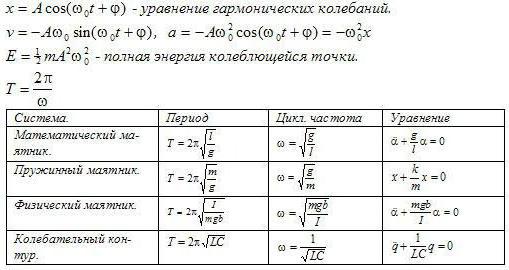 Finally, I want to touch on the topic of power. The work done by a force in one unit of time is called power. In fact, power is such a physical quantity that is a reflection of the ratio of work to a certain period of time during which this work was done: M = P / B, where M is power, P is work, B is time. The SI unit of power is 1 watt. A watt is equal to the power that does the work of one joule in one second: 1 W = 1J \ 1s.
Finally, I want to touch on the topic of power. The work done by a force in one unit of time is called power. In fact, power is such a physical quantity that is a reflection of the ratio of work to a certain period of time during which this work was done: M = P / B, where M is power, P is work, B is time. The SI unit of power is 1 watt. A watt is equal to the power that does the work of one joule in one second: 1 W = 1J \ 1s.






